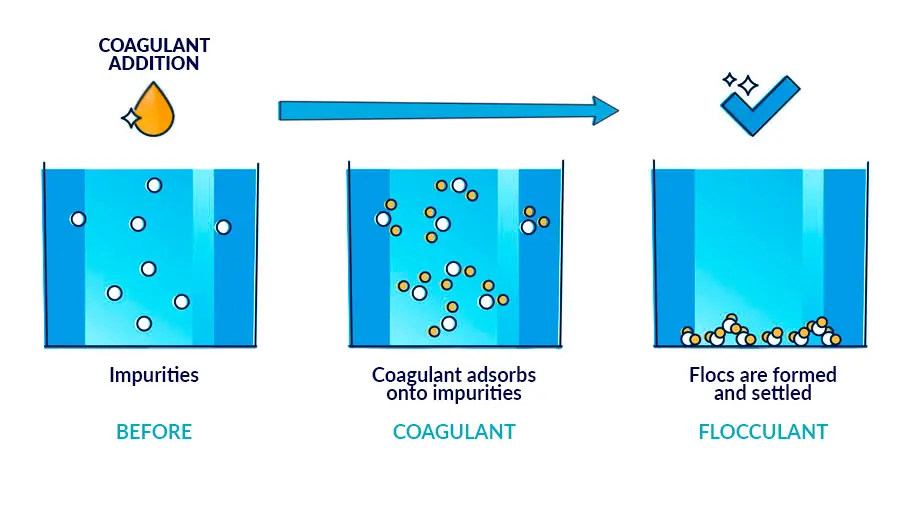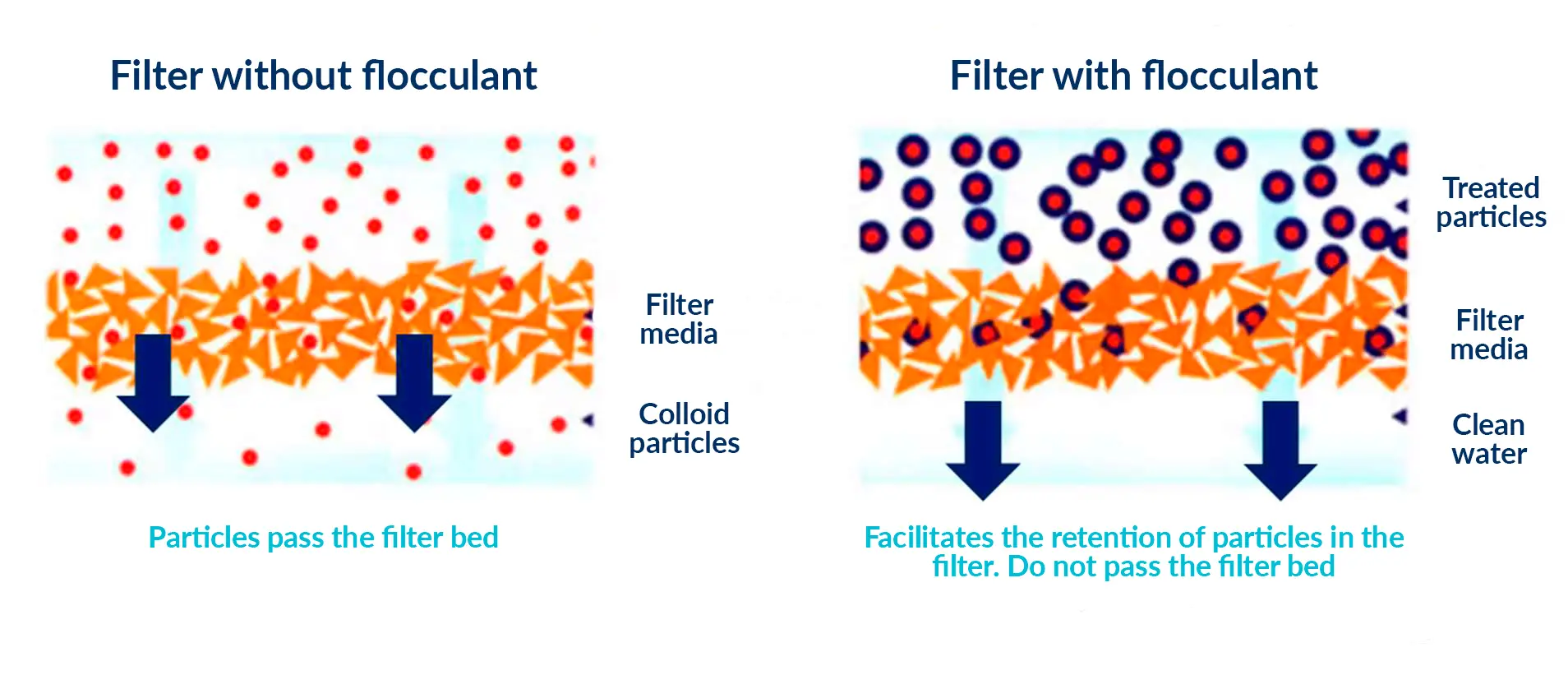The removal of small particles represents a challenge for most pool filtration systems. Flocculation and coagulation in water treatment turn out to be a solution to this issue.
Flocculation and coagulation in water treatment stand at the heart of every successful pool cleaning process today. Every pool operator knows that achieving total water transparency is key for their business success.
But fully clean and hygienic pools not only attract and retain swimming pool clients: they also drive down maintenance costs and may extend equipment life cycles.
In a nutshell, flocculation and coagulation in water treatment work together to eliminate small particles in pool water. Keep reading to find out how they do so, and the best options in the current market to guarantee water clarity.
Dive deeper with the eBook
What is coagulation and flocculation?
Coagulation in water treatment and flocculation are two separate and crucial processes for guaranteeing a swimming pool is kept clean. Used one after another, these two techniques clean water by overcoming the forces that would otherwise stabilize suspended particles.
In order to understand this, it is important to focus on how swimming pool water typically turns from transparent to cloudy. This unappealing look, where particles remain suspended on water, appears due to a series of reasons:
- Algae, bacteria, and other types of organic matter may be present
- Potential calcium and magnesium salts precipitations
- Dust, which could originate from the air or be brought in by swimming pool users
- Iron and manganese salts might oxidate
- Other factors such as mud, dirt, or rain
These particles set a specific challenge for swimming pool filtration systems and other types of water treatment equipment — they present a small size and cannot be processed.
Here is where coagulants and flocculants come in: through them, it’s possible to increase the size of these colloidal particles both in suspension and precipitation (that is, settled at the bottom of the pool vessel). As a consequence, they’re aggregated in small masses or flakes (called flocs), so that they can be eliminated by the filtration system or robot cleaners. When using an automated dosing system such as Floc System the settling at the bottom of the pool is avoided, as the process is performed at the water recirculation process.
Thus, flocculation and coagulation in water treatment remain crucial for all types of pool operators (from sports clubs to hospitality or water park installations), guaranteeing water transparency and the ensuing customer satisfaction.

Coagulation in water treatment
Coagulation in water treatment is the process of destabilizing suspended particles to reduce the separating forces between them. Coagulation is in fact the first step to remove small particles. To do so, a coagulant is added to the water for obtaining insoluble products. The coagulation process lasts for fractions of a second, although the reaction’s time frame might vary depending on the pH and alkalinity.
A good level of alkalinity guarantees the coagulants work efficiently, as this means the media won’t get acidified due to the action of aluminum sulfate. Otherwise, the pH would decrease and the coagulation reaction would stop.. Dependence on pH might be reduced by using higher quantities of coagulants.
Flocculation
Flocculation is a physical-chemical process that aims to remove colloids and suspensions.
- Colloids are defined as dispersions of microscopic particles (sized <1μm) in a solid state in water. Some examples of colloids include foams, aerosols, detergents, milk, or different types of clay.
- Suspensions are a heterogeneous mixture made up of particles (sized >1μm) and are suspended in a medium without being soluble. Orange juice represents a well-known example of a suspension.
Flocculation works by transporting phenomena within liquids so that these particles contact and form chemical bridges. A mesh of coagulum is then formed, presenting a three-dimensional and porous character.
Once these coagulated particles grow, the result is a floc large and heavy enough to settle and then be removed by filtration systems. In other words, this process takes place after coagulation has been performed, so that the final flocs are large enough to facilitate precipitation.
Benefits of coagulation and flocculation for pool operations
The use of flocculation and coagulation in water treatment is crucial to keep pools in optimal conditions, both in terms of hygiene and water quality. But a transparent, captivating water is not the only advantage of performing these operations, it also:
- represents a more efficient and sustainable water cleaning operation in terms of water savings and energy consumptions. For instance, it avoids using new water inputs to balance the pool’s water parameters.
- minimizes the need for disinfectants and other chemical products to keep water in optimal conditions for bathing.
Besides, these processes stand at the heart of today’s most efficient water treatment systems in pools, among other key operations such as the technology to obtain great air and water quality and correct pH levels.

Flocculation: How it works
There are various ways to dose and apply the flocculant:
Injecting into the water recirculation circuit.
This step might be automated in large public pools, using equipment such as the Floc System. This typically includes an adjustable pump , an injector valve, a bottom filter, suction and return tubes.
The process goes as follows: a dosing pump injects 0,5 ml of flocculant before the filter for each m3 of circulating water. If liquid flocculant is used, the automated system should be additionally supported by the pool maintenance team.
On the other hand, there are two options to dose the flocculant manually:
- Directly on the water: This option requires the filtration equipment to be stopped and swimmers out of the pool. Then, the right mix of flocculant and water (prepared in a container) must be poured, distributing it equally over the pool’s surface.
- In the skimmer: In this case, the flocculant (which might come in the shape of granules, tablets or cartridges) must be rightly dosed and placed in the skimmer, always after coagulation in water treatment has taken place. Regular values include 1 to 3 tablets per 100 m3.
Types of flocculation media
Flocculation media for swimming pools, just like coagulation in water treatment systems, come in a variety of forms
Liquid flocculant
Liquid flocculants are a new polymer that present great capacities, maximizing the elimination of colloidal particles found in pool water. Among its main uses are recovery for cloudy water, continuous maintenance and improving water quality and transparency.
Thanks to this product, it’s possible to not only improve the water’s bacteriological quality but also reduce the consumption of products used in disinfection and Ph adjustment.
Features:
- A high coagulation speed
- Good settling speed
- Good performance at low temperatures
- Effective in a wide range of pH levels
- Successful in eliminating the most minute particles, organic matter and metallic ions such as iron and magnesium
- Less tendency to cause overdosing phenomena
- It facilitates a lower content of soluble aluminum in treated water
Usage:
The filtration equipment must be turned off and swimmers must be out of the water. Then, the recommended dose must be added to a container of water and distributed evenly over the pool’s surface. Approximately 8 hours later, the particles deposited at the bottom of the vessel can be collected.
Granulated solid flocculant
This granulated compound represents another option to eliminate the smallest particles in suspension found in the pool water. Granulated solid flocculant options can be used for the continuous improvement of water transparency through permanent flocculation.
They may also be used to perform more economical water recovery processes, although their efficiency is slightly inferior to other alternatives.
Usage:
Again, the filtration equipment must be disconnected to use this product and bathers should not be in the pool. And this flocculation product should not be used if the pool’s filtration equipment works with diatoms.
The required dose must be poured into a container with water and spread evenly over the pool’s surface of the pool. Around 8 hours later, the flocs deposited at the bottom of the pool can be eliminated using pool cleaning equipment.
In tablets
Tablet flocculants come in a highly concentrated format that might vary from 20g to 100g. These are applied directly to the skimmer and are better suited for sand filters. Tablets present a progressive dissolution that completely eliminates suspended particles from the water.
In order to perform their function, these tablets form flocs at the filter inlet, which are then deposited on the surface of the filtering load, retaining all the suspended particles found in the pool water in its wake. This option may also be used for shock treatments that completely restore the water’s clarity and transparency.
Features:
- Tablet options present a coagulating and flocculant action, and eliminate metallic ions and manganese, as well as organic matter
- They generate less soluble aluminum content
- Tablets reduce the consumption of other disinfection products
- They do not clog the pool’s filters
- They require little space to be used
- Tablet formats avoid the presence of dirt in filters
Usage:
The first step is to check that the pH is well adjusted: between 7.2 and 7.6 are considered adequate levels. Then, the filter must be backwashed and, later on, the tablets can be placed in the skimmer basket or, if possible, inside the skimmer (in order to achieve a greater water flow).
Pools that present an overflow require the tablets to be placed inside a net or a bag and then within the compensation glass.
In cartridges
As we have seen above, it’s also possible to apply the flocculant directly in the skimmer. If that’s the case, cartridge flocculants stand out as one of the most suitable formats to effectively remove particles after coagulation in water treatment has taken place. This flocculant option is also ideal for sand filters.
Cartridges work by forming flocs in the water at the filter inlet, which are then deposited on the surface of the filtering load. Thus, they can retain all the suspended particles in water in its wake.
Features:
- Quickly applied
- Provide a continuous clarification effect for a week
- They contribute to the disinfecting action of other products
Usage:
Pool maintenance teams must check that the pool pH levels are between 7.2 and 7.6 by performing the required adjustments if needed. The filtration system must be washed beforehand. Then, the necessary product cartridges can be placed inside the skimmer baskets.
In single-dose gel capsules
Flocculants supplied in single-dose gel capsules represent another efficient option to complement coagulation in water treatment and to achieve crystal-clear water. In fact, their slow-dissolving formulation is specially designed to obtain great performance in filtration and completely eliminate suspended particles not retained by filters.
This option presents an effectiveness time of 15 days. It’s to be applied in the skimmer and it’s suitable for all types of pools.
Features:
- They eliminate organic matter
- Minimize the use of disinfection products
- Designed to be use easily
Usage:
A filter backwash and rinse must be performed. Then, remove the label and take out the tablet from the container.
Afterwards, the tablet must be placed inside the skimmer basket. After 24 hours, a second filter backwash must be performed, so that the normal filtration program can be resumed.
* The applying doses of each flocculation media must be consulted as it may vary according to each product, characteristics of the pool, weather, etc.
Flocculation and coagulation: water treatment at its best
All things considered, flocculation and coagulation in water treatment are today’s top choices to ensure water transparency. They represent key examples of today’s advancements in pool technology to make cleaning and maintenance easy, and to facilitate operators’ work overall.
Therefore, they represent a key investment in water treatment equipment that will ensure a pool’s longer life cycle and a successful economic performance. They’re indeed an ideal cleaning system: one that ensures a satisfactory experience.
